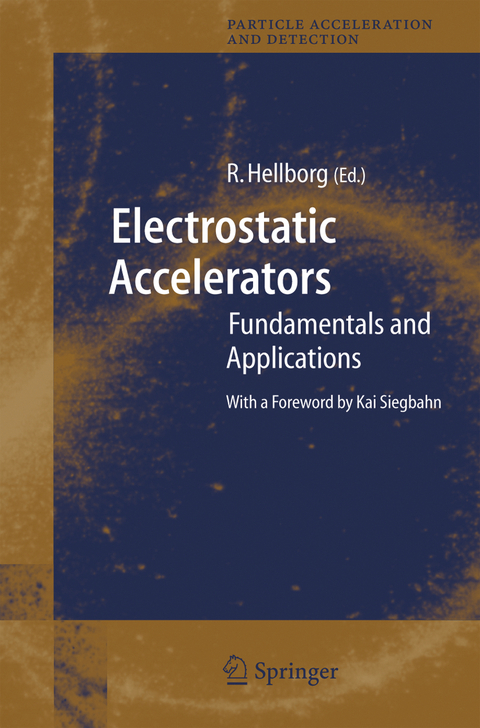
Electrostatic Accelerators
Springer Berlin (Verlag)
978-3-642-06309-1 (ISBN)
Electrostatic accelerators are an important and widespread subgroup within the broad spectrum of modern, large particle acceleration devices. They are specifically designed for applications that require high-quality ion beams in terms of energy stability and emittance at comparatively low energies (a few MeV). Their ability to accelerate virtually any kind of ion over a continuously tunable range of energies makes them a highly versatile tool for investigations in many research fields including, but not limited to, atomic and nuclear spectroscopy, heavy ion reactions, accelerator mass spectroscopy as well as ion-beam analysis and modification. The book is divided into three parts. The first part concisely introduces the field of accelerator technology and techniques that emphasize their major modern applications. The second part treats the electrostatic accelerator per se: its construction and operational principles as well as its maintenance. The third part covers all relevant applications in which electrostatic accelerators are the preferred tool for accelerator-based investigations. Since some topics are common to all types of accelerators, Electrostatic Accelerators will also be of value for those more familiar with other types of accelerators.
Accelerators.- to Part I - Accelerators.- Accelerators - an Introduction.- Accelerators for Medicine.- Accelerators for Synchrotron Radiation.- The Electrostatic Accelerator.- to Part II - the Electrostatic Accelerator.- History of the Electrostatic Accelerator.- Electrostatics.- Calculation Technique for High-Voltage Equipment in Gas.- Charging Systems.- Development of Charging Belts in Russia.- Cascade Generators.- Voltage Distribution Systems - Resistors and Corona Points.- Accelerator Tubes.- Development of Tubes in Obninsk, Russia.- Stabilization.- Stripper Systems.- Charge Exchange and Electron Stripping.- Carbon Stripper Foils - Preparation and Quality.- Positive-Ion Sources.- Negative-Ion Formation Processes and Sources.- Tandem Terminal Ion Source.- Ion Optics and Beam Transport.- Beam Envelope Techniques for Ion-Optical Calculations.- Equipment for Beam Diagnostics.- Computer Control.- Radiation Protection at an Accelerator Laboratory.- Nonradiation Hazards and Safety Considerations.- Confined-Space Maintenance.- Earthquake Protection - for Pelletrons.- Earthquake Protection of the Bucharest FN Tandem Accelerator.- Electrostatic-Accelerator Free-Electron Lasers.- Research Fields and Their Technical Requirements.- to Part III - Research Fields and Their Technical Requirements.- Isotope Production for Medical Applications.- Nuclear Structure.- Nuclear Reactions.- Detection of Explosives and Other Threats Using Accelerator-Based Neutron Techniques.- Accelerator Mass Spectrometry.- Atomic Collisions in Matter.- Modification of Materials by MeV Ion Beams.- Ion Beam Analysis.- Atomic Structure.- Industrial Electron Accelerators.
| Erscheint lt. Verlag | 12.2.2010 |
|---|---|
| Reihe/Serie | Particle Acceleration and Detection |
| Vorwort | K. Siegbahn |
| Zusatzinfo | XVI, 620 p. 275 illus. |
| Verlagsort | Berlin |
| Sprache | englisch |
| Maße | 155 x 235 mm |
| Gewicht | 948 g |
| Themenwelt | Naturwissenschaften ► Physik / Astronomie ► Atom- / Kern- / Molekularphysik |
| Naturwissenschaften ► Physik / Astronomie ► Hochenergiephysik / Teilchenphysik | |
| Technik ► Elektrotechnik / Energietechnik | |
| Schlagworte | accelerator mass spectroscopy • Computer • Control • electrostatic accelerators • Energie • Generator • High voltage • ion beam analysis • Laser • Neutron • Optics • spectroscopy • stability • Stabilization • synchrotron • Synchrotron radiation |
| ISBN-10 | 3-642-06309-8 / 3642063098 |
| ISBN-13 | 978-3-642-06309-1 / 9783642063091 |
| Zustand | Neuware |
| Haben Sie eine Frage zum Produkt? |
aus dem Bereich


